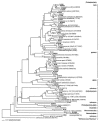Composition and diversity of microbial communities recovered from surrogate minerals incubated in an acidic uranium-contaminated aquifer
- PMID: 15466548
- PMCID: PMC522124
- DOI: 10.1128/AEM.70.10.6037-6046.2004
Composition and diversity of microbial communities recovered from surrogate minerals incubated in an acidic uranium-contaminated aquifer
Abstract
Our understanding of subsurface microbiology is hindered by the inaccessibility of this environment, particularly when the hydrogeologic medium is contaminated with toxic substances. In this study, surrogate geological media contained in a porous receptacle were incubated in a well within the saturated zone of a pristine region of an aquifer to capture populations from the extant communities. After an 8-week incubation, the media were recovered, and the microbial community that developed on each medium was compared to the community recovered from groundwater and native sediments from the same region of the aquifer, using 16S DNA coding for rRNA (rDNA)-based terminal restriction fragment length polymorphism (T-RFLP). The groundwater and sediment communities were highly distinct from one another, and the communities that developed on the various media were more similar to groundwater communities than to sediment communities. 16S rDNA clone libraries of communities that developed on particles of a specular hematite medium incubated in the same well as the media used for T-RFLP analysis were compared with those obtained from an acidic, uranium-contaminated region of the same aquifer. The hematite-associated community formed in the pristine area was highly diverse at the species level, with 25 distinct phylotypes identified, the majority of which (73%) were affiliated with the beta-Proteobacteria. Similarly, the hematite-associated community formed in the contaminated area was populated in large part by beta-Proteobacteria (62%); however, only 13 distinct phylotypes were apparent. The three numerically dominant clones from the hematite-associated community from the contaminated site were affiliated with metal- and radionuclide-tolerant or acidophilic taxa, consistent with the environmental conditions. Only two populations were common to both sites.
Figures


References
-
- Baker, B., and J. F. Banfield. 2003. Microbial communities in acid mine drainage. FEMS Microbiol. Ecol. 44:139-152. - PubMed
-
- Bekins, B. A., E. M. Godsy, and E. Warren. 1999. Distribution of microbial physiologic types in an aquifer contaminated by crude oil. Microb. Ecol. 37:263-275. - PubMed
-
- Caccavo, F., Jr., and A. Das. 2002. Adhesion of dissimilatory Fe(III)-reducing bacteria to Fe(III) minerals. Geomicrobiol. J. 19:161-177.
-
- Chang, Y. J., A. D. Peacock, P. E. Long, J. R. Stephen, J. P. McKinley, S. J. Macnaughton, A. Hussain, A. M. Saxton, and D. C. White. 2001. Diversity and characterization of sulfate-reducing bacteria in groundwater at a uranium mill tailings site. Appl. Environ. Microbiol. 67:3149-3160. - PMC - PubMed
Publication types
MeSH terms
Substances
Associated data
- Actions
- Actions
- Actions
- Actions
- Actions
- Actions
- Actions
- Actions
- Actions
- Actions
- Actions
- Actions
- Actions
- Actions
- Actions
- Actions
- Actions
- Actions
- Actions
- Actions
- Actions
- Actions
- Actions
- Actions
- Actions
- Actions
- Actions
- Actions
- Actions
- Actions
- Actions
- Actions
- Actions
- Actions
- Actions
- Actions
- Actions
- Actions
- Actions
- Actions
- Actions
- Actions
- Actions
- Actions
- Actions
LinkOut - more resources
Full Text Sources
Other Literature Sources
Molecular Biology Databases

